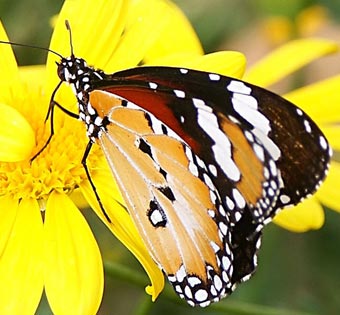Butterflies & Moths
What is a butterfly?

Butterflies are beautiful, flying insects with large scaly wings. Like all insects, they have six jointed legs, 3 body parts, a pair of antennae, compound eyes, and an exoskeleton. The three body parts are the head, thorax (the chest), and abdomen (the tail end).
The butterfly's body is covered by tiny sensory hairs. The four wings and the six legs of the butterfly are attached to the thorax. The thorax contains the muscles that make the legs and wings move.
Butterflies are found all over the world and in all types of environments: hot and cold, dry and moist, at sea level and high in the mountains. Most butterfly species, however, are found in tropical areas, especially tropical rainforests.
What is a moth?

Although sometimes not as showy as their cousins, the butterflies, moths are often just as beautiful and often more fascinating. In general moths are more broad-based in their choice of larval foodplant. The caterpillars of some moth species will eat a wide range of foodplants.
Most moths fly at night by moonlight in search of nectar rich flowers to feed on.
Just as butterflies have to avoid capture by birds during the daytime, night flying moths have to avoid capture by bats. Moths have sensitive ears, located near where the hind wings join the body. When they hear the ultrasonic squeak of a bat, they close their wings, and drop like a stone out of harms way.